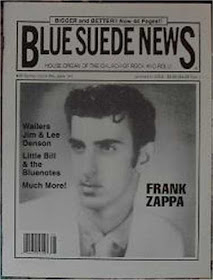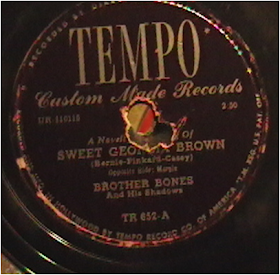 |
| "I'm probably more famous for sitting on a toilet than for anything else I do." from a July 1, 1983 interview for Nationwide, the BBC news program. |
The May Co. was a chain of middle-class department stores in Southern California when I was growing up. Since my mother didn't drive, Saturdays were spent shopping - my dad patiently plogging along, me not-so-patiently and forced into coming, to boot. (Hey! It was my day off!) I wandered over to their music department where they had started selling rock posters (I believe you can get your Justin Bieber fix at Walmart today), and was leafing through the hinged wall display. All of a sudden I came across the above Frank Zappa poster. Then I heard a loud guffaw behind me, breaking out into laughter. It was my dad, unbeknownst to me he had followed me. Relief flooded through me that he wasn't mad I'd found a man on a toilet. He thought it was funnier then I did!
 |
| Zappa in Toronto, 1977. Image courtesy of Wikipedia. |
I didn't buy it (didn't even ask!) but it became a buzz word between us, especially at report card times when the subject of college came up. He did let me buy a "Beer, Breakfast of Champions" poster, after I stated that Benjamin Franklin believed in beer - showing off what you've learned in school is a good marketing ploy for a kid, even if you didn't learn it at school ;-). However, this incident did start a predilection and preoccupation with everything Zappa.
Zappa on education, from his liner notes for Freak Out! (6/17/66):
Drop out of school before your mind rots from exposure
to our mediocre educational system. Forget about the
Senior Prom and go to the library and educate yourself
if you have any guts. Some of you like Pep rallies and plastic
robots who tell you what to read. Forget I mentioned it.
This song has no message. Rise for the flag salute.
Zappa was a prolific composer and songwriter. He wrote jazz, rock, orchestral, and musique concrète, a form of electroacoustic music utilizing acousmatic sound as a compositional resource. Developed in the early 1940s, this genre did not restrict compositions to the sounds of instruments and voices, nor the traditional elements, such as melody, harmony, etc. Zappa developed a taste for avant-garde music while in his teens, and began writing classical music in high school while performing in rhythm and blues bands.
His father was a chemist and mathematician and worked in the defense industry. At one point in his childhood the family lived near an arsenal where mustard gas was stored, and gas masks were kept in the home. He suffered from many health problems as a child. Zappa was later a strident critic of the defense industry, political and social structures, organized religion, and mainstream education. His family moved to California for health reasons.
 |
| "Special Section on Musicology: Popular Music from Adorno......to Zappa." |
When the family moved to the high desert area of the Antelope Valley in northern L.A. county, Zappa met Don Vliet in high school. Vliet became Captain Beefheart, and they influenced each other throughout their careers. Zappa attended a series of community colleges but became disgusted with the field of education. Later he took his own four children out of school at age 15, and refused to pay for their college education.
 |
| Zappa graduated from Antelope Valley High School. |
After moving out on his own he became involved in advertising, a career that didn't last long but taught him much that he used in his life. He always was concerned about the presentation of his work, often designing his own album covers and directing his own films and videos.
 |
| Zappa in 1975, courtesy of Getty Images. |
In the early 60s he tried to earn a living as a composer and musician, and wrote and produced songs for other artists. Eventually he was able to stage a concert of his orchestral music in 1963 and recorded and broadcast it. On the Steve Allen show that year he played a bicycle as a musical instrument. He and Vliet recorded some songs under the name The Soots, but were unable to get a record contract.
 |
| Captain Beefheart and Frank Zappa. |
He began working at a studio and performing with a trio called The Muthers in local bars. At one point police began to get suspicious about what was going on at the studio, and Zappa was approached by a vice squad undercover officer and given $100 to make a porn tape for an alleged stag party. Zappa and a female friend faked an erotic episode, and he was arrested when he handed over the tape. He was charged with "conspiracy to commit pornography", but the felony charge was reduced and he was sentenced to six months on a misdemeanor charge, reduced to all but ten days. This experience added to his anti-authority posture.
 |
| Zappa at the (infamous) Studio Z. Image courtesy of this site. |
In the late 60s he took over as guitarist in a group called The Soul Giants. He convinced them to play his music and they renamed themselves The Mothers. When they signed with Verve Records the band's name was changed to The Mothers of Invention at Verve's insistence, as "Mother" had slang derogatory connotations. "Freak Out!" was released in 1966, the second rock double album ever released (following Dylan's "Blonde on Blonde"). This established them as a radical new voice.
 |
| Image courtesy of Wikipedia. |
In 1967 they moved to New York and performed for two years at the Garrick Theater, where they developed a show that showcased all the band members as well as Zappa's music. In 1968, they released "We're Only in It For the Money" which was hailed as having some of the most creative audio editing and production ever heard in pop music. While in New York, Zappa began using tape editing as a compositional tool more and more. Later he combined recordings of different compositions into new pieces, dubbing this process "xenochrony", reflecting the Greek words for strange and time. He also established a compositional approach he called "conceptual continuity", which meant any album or project was part of a larger project, so musical themes and lyrics reappeared in later albums.
Zappa broke up The Mothers of Invention in 1969, in part because his music was becoming more instrumental jazz and classical oriented. He began releasing solo albums, playing extended guitar solos. In 1970 he formed a new version of The Mothers (dropping the "of Invention"), and this band was featured on the double-album soundtrack to the movie 200 Motels (1971).
In the early 70s the group experienced some events that put them in limbo for a while. In 1971, while performing in Switzerland, an audience member started a fire that burned down the place and destroyed their equipment. A week later they played in London with rented gear. An audience member pushed Zappa off the stage, about ten feet onto concrete. resulting in serious fractures, head trauma, and injuries to his back, leg, and neck, and a crushed larynx, which dropped his voice a third after he healed. He was still plugged into his amp which came crashing down on him. The band set out on their own while Zappa recuperated.
 |
| When Zappa was pushed off stage, the band thought at first that he was dead. |
Zappa went through a lot of business breakups and set-backs in the 70s, at times losing control of his own material. By the end of the decade he was performing as a solo artist, and released some songs with controversial lyrics. He also developed his career in film and television.
The 80s were a time of much productivity for him. Unfortunately, most people remember him for his satirical lyrics and think of him as a writer and performer of novelty songs. "Valley Girl", with lyrics improvised by his daughter Moon Unit, added to this reputation, and the rest of the album was ignored. Because of this, Zappa never played the song live. One of the compositional techniques Zappa experimented with in the 80s was sprechstimme (speaking voice), which showcased some of the most accomplished musicians he ever played with. (Schoenberg and Berg had used the technique.)
 |
| Moon Unit and Frank Zappa. |
In 1985, Zappa testified before the U.S. Senate Commerce, Technology, and Transportation committee about censorship. The Parents Music Resource Center (PMRC) had been founded to address the issue of songs with sexual or satanic content, headed by Tipper Gore and including many politician's wives. Zappa stated that since First Amendment rights are decided for the least restrictive preference, that the PMRC's demands were "the equivalent of treating dandruff by decapitation".
 |
| Testifying before the Senate. Image courtesy of Wikipedia. |
In the late 80s he began a re-release program of all his earlier vinyl recordings from the 60s, 70s, and early 80s on CDs. Some fans complained that these weren't faithful to the original. Zappa had a proposal to sell direct digital-to-digital transfer via phone or cable TV, with automatic billing built in to the software, predating online music stores by about 20 years. When it didn't take off, he considered his idea a flop.
 |
| Caricature by Zach Bellissimo. Check out his tattoos of this and a caricature of Tom Waits! (Zappa was a heavy cigarette smoker, but eschewed marijuana and drugs.) |
Many of Zappa's projects came to a halt in 1990 when he was diagnosed with an advanced case of inoperable prostate cancer. Three years later he died, but in that time he devoted his energy to modern orchestral and Synclavier works.
Oddly enough, scientists have honored Zappa by naming their discoveries after him: Amaurotoma zappa (an extinct mollusc); Zappa confluentus (a genus of gobiid fishes from New Guinea); Phialella zappai (a California jellyfish); Pachygnatha zappa (a Cameroonese spider); zapA (a gene of a bacterium); and Spygori zappania (a metazoan fossil). There is also an asteroid named for him - 3834 Zappafrank. All to honor his challenge of convention and traditional beliefs.
Zappa today is considered one of the most original composers and guitarists of his era, and has been a major influence on composers and musicians. Another one of those rare individuals who lived according to his beliefs and pursued life on his own terms.
***************
Here is Wikipedia's Frank Zappa discography.
Unless otherwise noted, all images courtesy of www.zappa.com.
*******************************







































